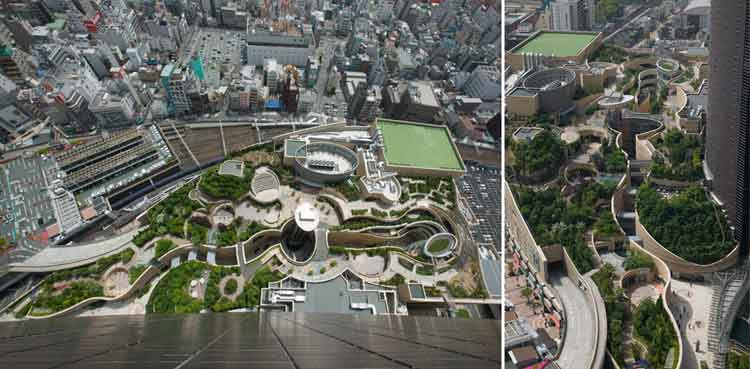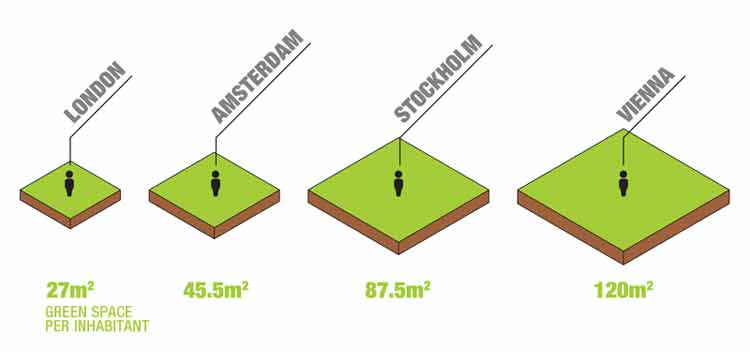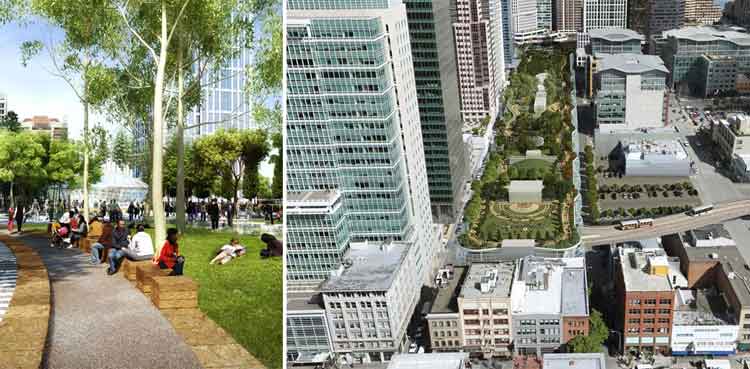Liveable cities: How much green space does your city have?
Today, it is estimated that over 50% of the world’s population are living in urban areas. By 2050, this figure will increase to 70% and already many cities across the world are struggling to cope with pressure from a rapidly increasing population.
Housing supply, unemployment levels, pollution and outdated infrastructures are just some of the biggest challenges that are impacting the quality of our living, all of which have an impact on what makes great liveable cities. Green space is another, and the race to create the greenest city is on!
Some of the world’s most liveable cities provide publicly accessible green spaces* with physical amenities in the heart of their neighbourhoods. It should therefore come as no surprise that Vienna, which regularly ranks in the top positions for the world’s most liveable cities, is one of the greenest cities of over a million inhabitants in the world!
51% of Vienna is classified as green space. For each of Vienna’s 1.7 million inhabitants, there are 120 square meters of green space. This figure is also set to grow as the city is funding projects to green up courtyards and façades, as well as planting new avenue trees. [source: wien international]
The Siemens Green City report suggests that Singapore, which is the third-densest city in the world, should be a role model for spatial planning as the city has been able to combine extensive green spaces with high population density.
The World Health Organization (WHO) has suggested that every city should have a minimum of 9 square metres of green space per person. Yet Istanbul, which has a population of over 14 million people, provides only 6.4 square metres of green space per person. Tokyo and Buenos Aires provide some of the lowest at 3 square metres and 1.9 square metres per person respectively.
How does your city compare to Vienna?

Designing the greenest city on Earth
Accessible green space has long been one of the key components to Vancouver’s success as a liveable city. The city has already close to 300 city-run parks, beaches, and gardens and is the only municipality in Canada with an elected park board.
Vancouver, which has also consistently ranked in the top positions for liveable cities, is now also aiming to be the “greenest city in the world by 2020”. The city is working with residents, businesses and organizations to implement the “2020 action plan” which is divided into 10 goals, each with a specific target for 2020. Some of these targets are aimed at improving green space and access to nature, such as planting 150,000 additional trees, and ensuring every person lives within a 5 minute walk to nature.

Other projects within the 2020 action plan include reducing the amount of solid waste going to landfills by half, and doubling the amount of green jobs. Read the full list of projects and targets here.
Over the years, Vancouver’s urban planning has become so successful in creating a liveable city, there is now an internationally known term called “Vancouversim”. According to the City of Vancouver, “Vancouverism combines deep respect for nature with enthusiasm for busy, engaging, active streets and dynamic urban life”.
More than 7200 miles away from Vancouver, Dubai decided to take a literal approach to “Vancouversim”. The Dubai Marina in United Arab Emirates was a near-replica of down-town Vancouver when the initial plans were launched. Urban Designer and architectural historian-critic Trevor Boddy described the project as almost a perfect clone of down-town Vancouver; “Right down to the handrails on the seawall, the skinny condo towers on townhouse bases, all around a 100 percent artificial, full-scale version of False Creek filled with seawater from the Persian Gulf.”
Stanley Kwok, [the Architect behind the original False Creek and was involved with the Dubai Marina project], revealed during a presentation, that as Dubai Marina evolved, Green spaces were sacrificed for more buildings. Thus the area became too dense and uncontrolled.
Cities need to look at creative solutions to increase green space, rather than sacrifice these spaces to build more buildings.
Innovation in Green Space
Creating new accessible green spaces in dense cities can be a challenge. As a result, some cities are looking at more creative and innovative solutions, some of which have been inspired by the success of the high line in New York. These cities are literally building parks in the sky. Below are a few examples:
Osaka, Japan

Image Source: WAN
Namba Parks is an office & shopping mall complex located in Osaka, Japan. The unique feature of the development is the rooftop park that gradually ascends eight levels in a densely built area, connecting the park to the street. It provides a variety of green spaces in an area where nature is sparse.
San Francisco, USA
Image Source: PWPLA
More than 11 acres of new public parks and open spaces, including a 5.4 acre rooftop park is to be constructed in San Francisco’s Transbay Neighbourhood. This 1400 foot long elevated park will provide a range of amenities and activities which includes an outdoor amphitheatre, gardens, trails, open grass areas, children’s play areas as well as a restaurant and café.
Rotterdam, Netherlands
Image Source: Doepel Strijkers
“Hofbogen” is a project to transform an old elevated train track in downtown Rotterdam into a sky park. This project also connects Rotterdam Airport and adjacent developments to the city district heating network, thereby reducing their CO2 footprint.
The Opportunities of Green Space.
It takes a holistic approach to create a liveable city, but bringing people closer to nature is one of the most important steps in this process. Our cities are becoming denser and what we need today is a variation of green space solutions. A ground-up approach to the design of our neighbourhoods should always be our primary goal, but what is evident is that there are other creative ways of creating healthy places.
This presents great opportunities for place makers to create innovative green spaces that are accessible, inclusive and inspiring. Ultimately, it is these spaces that contribute to a city’s greatness, as John Ruskin professed:
The measure of any great civilisation is in its cities, and a measure of a city’s greatness is to be found in the quality of its public spaces, its parks and its squares.’
*Accessible green space is considered to be that which is located close to residents’ homes, easy to walk to, physically accessible, safe to use, and provides well maintained facilities. [Definition by Public Health England]
About the author

Baharash Bagherian is a Designer working holistically at all scales, designing for a higher quality of life whilst also protecting the environment. He believes that great Architecture is more than buildings: “It’s about creating resilient destinations that make people feel healthy to live in, inspired to work in and want to visit.”
In his work, each project is driven by a process of investigation and experimentation. The outcomes of these studies form the basis of the design. He strives to develop innovative and creative solutions that make a positive contribution to our current and future generations.
His award-winning design studio, Baharash Architecture, have worked on projects in various scales, from urban scale; such as master plans, landscape design and buildings, to smaller scale; such as interiors, furniture and products. Recent projects include the Oasis Eco Resort in Liwa and phase 2 of Dubai Sustainable City.








